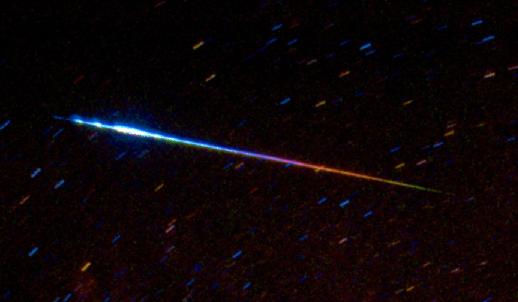Credit & Copyright: S.
Kohle & B. Koch
(Astron. I., U. Bonn)
Explanation:
Tonight the
Perseid
Meteor Shower reaches its maximum. Grains of rocky ice will
streak across the sky as they evaporate during entry into
Earth's
atmosphere. These ice chips were shed from
Comet Swift-Tuttle. The
Perseids result from the annual
crossing of the Earth through Comet Swift-Tuttle's orbit. The
Perseids
are typically the most active
meteor shower of the year.
In a clear dark sky, an observer might see a meteor a minute.
Pictured above is a Perseid
meteor
from 1993. The colors are representative but digitally enhanced. As the
meteor streaked across the night sky,
different excited atoms emitted different colors of light.
The origin of the green tinge visible at the right is currently unknown,
however, and might result from
oxygen
in Earth's atmosphere. Perseid meteors can best be seen from a relaxing position, away from lights.
Authors & editors:
Robert Nemiroff
(MTU) &
Jerry Bonnell
(USRA)
NASA Web Site Statements, Warnings,
and Disclaimers
NASA Official: Jay Norris.
Specific
rights apply.
A service of:
LHEA at
NASA /
GSFC
& Michigan Tech. U.
Based on Astronomy Picture
Of the Day
